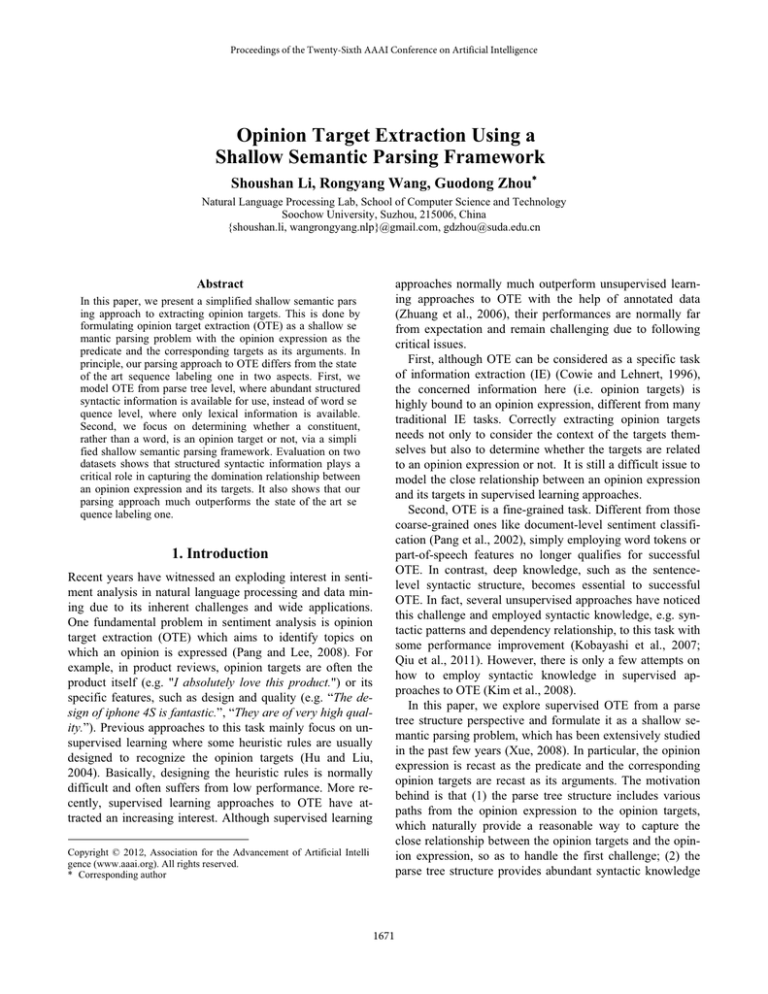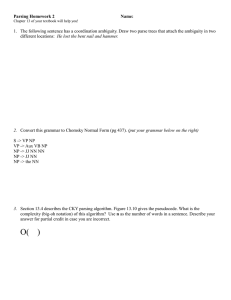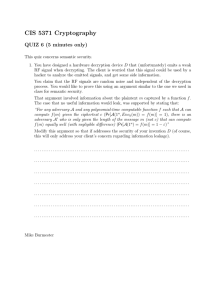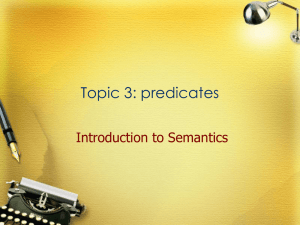
Proceedings of the Twenty-Sixth AAAI Conference on Artificial Intelligence
Opinion Target Extraction Using a
Shallow Semantic Parsing Framework
Shoushan Li, Rongyang Wang, Guodong Zhou
Natural Language Processing Lab, School of Computer Science and Technology
Soochow University, Suzhou, 215006, China
{shoushan.li, wangrongyang.nlp}@gmail.com, gdzhou@suda.edu.cn
approaches normally much outperform unsupervised learning approaches to OTE with the help of annotated data
(Zhuang et al., 2006), their performances are normally far
from expectation and remain challenging due to following
critical issues.
First, although OTE can be considered as a specific task
of information extraction (IE) (Cowie and Lehnert, 1996),
the concerned information here (i.e. opinion targets) is
highly bound to an opinion expression, different from many
traditional IE tasks. Correctly extracting opinion targets
needs not only to consider the context of the targets themselves but also to determine whether the targets are related
to an opinion expression or not. It is still a difficult issue to
model the close relationship between an opinion expression
and its targets in supervised learning approaches.
Second, OTE is a fine-grained task. Different from those
coarse-grained ones like document-level sentiment classification (Pang et al., 2002), simply employing word tokens or
part-of-speech features no longer qualifies for successful
OTE. In contrast, deep knowledge, such as the sentencelevel syntactic structure, becomes essential to successful
OTE. In fact, several unsupervised approaches have noticed
this challenge and employed syntactic knowledge, e.g. syntactic patterns and dependency relationship, to this task with
some performance improvement (Kobayashi et al., 2007;
Qiu et al., 2011). However, there is only a few attempts on
how to employ syntactic knowledge in supervised approaches to OTE (Kim et al., 2008).
In this paper, we explore supervised OTE from a parse
tree structure perspective and formulate it as a shallow semantic parsing problem, which has been extensively studied
in the past few years (Xue, 2008). In particular, the opinion
expression is recast as the predicate and the corresponding
opinion targets are recast as its arguments. The motivation
behind is that (1) the parse tree structure includes various
paths from the opinion expression to the opinion targets,
which naturally provide a reasonable way to capture the
close relationship between the opinion targets and the opinion expression, so as to handle the first challenge; (2) the
parse tree structure provides abundant syntactic knowledge
Abstract
In this paper, we present a simplified shallow semantic pars
ing approach to extracting opinion targets. This is done by
formulating opinion target extraction (OTE) as a shallow se
mantic parsing problem with the opinion expression as the
predicate and the corresponding targets as its arguments. In
principle, our parsing approach to OTE differs from the state
of the art sequence labeling one in two aspects. First, we
model OTE from parse tree level, where abundant structured
syntactic information is available for use, instead of word se
quence level, where only lexical information is available.
Second, we focus on determining whether a constituent,
rather than a word, is an opinion target or not, via a simpli
fied shallow semantic parsing framework. Evaluation on two
datasets shows that structured syntactic information plays a
critical role in capturing the domination relationship between
an opinion expression and its targets. It also shows that our
parsing approach much outperforms the state of the art se
quence labeling one.
1. Introduction
Recent years have witnessed an exploding interest in sentiment analysis in natural language processing and data mining due to its inherent challenges and wide applications.
One fundamental problem in sentiment analysis is opinion
target extraction (OTE) which aims to identify topics on
which an opinion is expressed (Pang and Lee, 2008). For
example, in product reviews, opinion targets are often the
product itself (e.g. "I absolutely love this product.") or its
specific features, such as design and quality (e.g. “The design of iphone 4S is fantastic.”, “They are of very high quality.”). Previous approaches to this task mainly focus on unsupervised learning where some heuristic rules are usually
designed to recognize the opinion targets (Hu and Liu,
2004). Basically, designing the heuristic rules is normally
difficult and often suffers from low performance. More recently, supervised learning approaches to OTE have attracted an increasing interest. Although supervised learning
Copyright © 201 , Association for the Advancement of Artificial Intelli
gence (www.aaai.org). All rights reserved.
* Corresponding author
1671
Table 1: Example of an annotated sentence in the DSRC
corpus
<word id "word 1">I've</word>
Data
to better recognize opinion targets, so as to handle the second challenge. In principle, recasting an opinion target as a
constituent in a parse tree provides more potential to better
represent its close relationship with the opinion expression
than as a string in a word sequence.
Our parsing approach to supervised OTE differs from existing studies in two aspects. First, we extend OTE from the
word sequence level into the parse tree level, where structured syntactic information is available. Second, we focus
on determining whether a constituent in a parse tree, rather
than a string in a word sequence, is an opinion target or not.
Evaluation on two datasets shows that our parsing approach
much outperforms the state-of-the-art sequence labeling one
by Jakob and Gurevych (2010).
Markables
2. Related Work
<word id "word 2">always</word>
<word id "word 3">been</word>
<word id "word 4">pretty</word>
<word id "word 5">dubious</word>
<word id "word 6">about</word>
<word id "word 7">the</word>
<word id "word 8">concept</word>
<word id "word 9">of</word>
<word id "word 10">online</word>
<word id "word 11">universities</word>
1. <markable span "word 10..word11" annotation_type= "target" />
2. <markable
span
"word 5"
annotation_type="opinion expression" />
Table 2 gives the statistics of each dataset. From this table, we can see that the average length of opinion targets is
less than two, with 86.81%/8.17%/4.17%/0.85% containing
one/two/three//more words in the university dataset and
81.46%/12.84%/5.37%/0.32% containing one/two/three/
more words in the web-service dataset.
While there is a certain mount of literature within the NLP
community on unsupervised OTE (Hu and Liu, 2004; Popescu and Etzioni, 2005; Blei and Jordan, 2006; Bloom et al.,
2007; Kim and Hovy, 2006; Titov and McDonald, 2008),
supervised learning to OTE is relatively new.
Zhuang et al. (2006) obtain various dependency relationship templates from an annotated movie corpus and apply
them to supervised OTE. Empirical evaluation shows that
their template-based classification approach greatly outperforms the unsupervised one by Hu and Liu (2004).
Kessler and Nicolov (2009) model OTE as a ranking
problem and extract the highest ranked candidates as opinion targets. Empirical evaluation shows that their candidate
ranking approach outperforms several unsupervised ones.
Jakob and Gurevych (2010) model OTE as a word sequence labeling problem. Empirical evaluation shows that
their sequence labeling approach much outperforms both the
template-based classification approach by Zhuang et al.
(2006) and the candidate ranking approach by Kessler and
Nicolov (2009), representing the state-of-the-art in supervised OTE.
Instead, our constituent parsing approach addresses OTE
from a parse tree structure perspective.
Table 2: Statistics of the DSRC corpus
Number
University
Web services
Documents
256
234
Sentences
2911
7575
Sentences with opinion
1012
1372
Targets
1175
1861
Target types
335
661
Average length of targets
1.48
1.37
For preprocessing, all the sentences in the DSRC corpus
are parsed using the Stanford Parser2, which is a Java implementation of probabilistic natural language parsers, including both a highly optimized PCFG parser and a lexicalized dependency parser (Klein and Manning, 2003).
4. OTE via Shallow Semantic Parsing
In this section, we first formulate the OTE task as a shallow
semantic parsing problem. Then, we deal with it using a
simplified shallow semantic parsing framework.
3. DSRC Corpus
This study employs the DSRC corpus1, as described in Toprak et al. (2010), which contains two datasets: university
and web-service. In the corpus, every sentence is annotated
with opinion expressions, and their corresponding opinion
holders and opinion targets, and so on. Table 1 shows an
example of such annotation scheme. In this paper, we only
focus on the opinion targets.
1
4.1 Formulating OTE as a Shallow Semantic Parsing Problem
Given a parse tree and a predicate in it, shallow semantic
parsing recognizes and maps all the constituents in the sentence into their corresponding semantic arguments (roles) of
2
http://www.ukp.tu darmstadt.de/data/sentiment analysis/
1672
http://nlp.stanford.edu/software/lex parser.shtml#Citing
Arguments
Predicate
S0,7
NP0 2
DT0,0
The
NN1,1
calendar
VP3,7
NN2,2
VBZ3,3
feature
ADJP4,7
is
JJ4,4
good
CC5,5
RB6,6
but
not
JJ7,7
excellent
Figure 1: Illustration of an opinion expression (predicate) and its corresponding opinion targets (arguments) in a parse tree
the predicate. As far as OTE considered, the opinion expression can be regarded as the predicate, while the opinion targets can be mapped into its arguments. For example,
in the sentence "The calendar feature is good but not excellent." as shown in Figure 1, two opinion expressions of JJ4,4
and JJ7,7 are found and the opinion target consists of two
words: NN1,1 and NN2,2. In this study, we assume opinion
expressions have been recognized and treat the nearest
opinion expression to an opinion target as its predicate.
Thus, in this example, JJ4,4 is considered as a predicate and
NN1,1 and NN2,2 are considered as two arguments.
In particular, given a opinion expression and one of its
opinion targets, which contains m words: word1, …, wordm,
we adopt following three heuristic rules to map the opinion
target into several constituents which can be deemed as its
arguments in the given parse tree.
(1) The opinion expression itself and all of its ancestral
constituents are non-arguments.
(2) If all child constituents of constituent X are recognized as arguments, then X is labeled as an argument and
all its child constituents are re-labeled as non-arguments.
(3) If not all of the child constituents of constituent X are
recognized as arguments, then X is labeled as a nonargument.
The first rule ensures that no argument covers the opinion expression while the remaining two rules ensure no
overlap between any two arguments in an opinion target.
These constraints between a predicate and its arguments
are somehow consistent with shallow semantic parsing
(Carreras and Màrquez, 2005). For example, NN1,1 , NN2,2
and NP0, 2 cannot be arguments at the same time because
NP0, 2 's child DT0,0 is not a argument (NN1,1 , NN2,2 and
NP0, 2 are overlapped).
Compared with traditional shallow semantic parsing
which needs to assign an argument with a semantic label,
OTE does not involve semantic label classification and
thus can be simplified into three phases: argument pruning,
argument identification and post-processing.
4.2 Argument Pruning
Argument pruning aims to filter out those constituents
which are most likely non-arguments of a predicate according to some heuristic rules. Here, we propose two pruning
rules as follows:
(1) The predicate constituent itself and its ancestral constituents in the parse tree are filtered out as non-arguments.
(2) The constituents which contain more than three leaf
nodes in the parse tree are filtered out as non-arguments
and instead, their child constituents are considered as arguments candidates individually.
Here, the first rule is adopted mainly due to the first constraint as described in Section 4.1 while the second rule is
proposed mainly due to the statistics of opinion targets.
Generally, an opinion target contains less than four words.
For example, as pointed in Section 3, only 0.85% of opinion targets contain more than three words in the DSRC
corpus. Furthermore, we can simply merge the separated
arguments to form an opinion target when it contains more
than three words. In this way, many of non-argument constituents can be filtered out safely and conveniently. Take
Figure 1 as an example, S0,7, VP3,7, and ADJP4,7 are filtered
out according to the first rule since they are ancestral constituents of the predicate constituent JJ4,4.
4.3 Argument Identification
For remaining argument candidates, we employ a binary
classifier to determine whether an argument candidate is an
argument or not, using following two groups of features:
basic features and additional features.
1673
opinion target extractor recognizes the whole noun phrase
"the calendar feature" as an opinion target. In fact, the annotation on this type of opinion targets is not consistent in
the original corpus: some starter determiners and pronouns
are contained in the opinion targets while others not. To
keep consistency, we delete such starter determiners and
pronouns from opinion targets in the annotated corpus.
Overall, 0.55% of the opinion targets are concerned. Similarly, during post-processing, we delete those starter determiners and pronouns from extracted opinion targets.
Basic Features
Table 3 lists the basic features for argument identification.
These features are directly related with the predicate and
the argument candidate, and have been widely used in
common shallow semantic parsing for both verbal and
nominal predicates (Xue, 2008).
Table 3: Basic features and their instantiations for OTE,
with NN1,1 (calendar) as the focus argument candidate and
JJ4,4 (good) as the given predicate, with regard to Figure 1.
Feature
Remarks
B1 The opinion expression (good)
B2 The syntactic category of the argument candidate
(NN)
B3 The headword of the argument candidate (calendar)
B4 The POS of the headword of the argument candidate (NN)
Table 4: Additional features and their instantiations for
OTE, with NN1,1 (calendar) as the focus argument candidate and JJ4,4 (good) as the given predicate, with regard to
Figure 1.
Feature
Remarks
Argument candidate (Arg) related context features
Arg1 The left word and its POS. (the, DT)
Arg2 The right word and its POS. (feature, NN)
Additional Features
To capture more useful information in opinion targets and
opinion expressions, we also explore various kinds of additional features in capturing more details regarding the argument candidate and the predicate, as shown in Table 4.
In particular, we categorize the additional features into
three groups according to their relationship with the argument candidate (Arg, in short) and the given predicate (Pre,
in short). In particular, various parsing paths are included
to capture the relationship between the opinion target and
the opinion expression.
Since some proposed features may not be effective in
argument identification, we adopt a greedy feature selection algorithm, as described in Jiang and Ng (2006), to pick
up effective features incrementally according to their contributions on the development data. Specially, the algorithm repeatedly selects one feature each time which contributes most, and stops when adding any of the remaining
features fails to improve the performance. As far as OTE
concerned, the whole feature selection process could be
done by first running the selection algorithm with the basic
features (B1-B4) and then incrementally picking up effective features from the additional features (Arg1 - Arg2,
Pre1 - Pre2, and A-P1 - A-P8).
Predicate (Pre) related context features
Pre1 The left word and its POS. (is, VBZ)
Pre2 The right word and its POS. (but, CC)
Arg-Pre-related structured features
A-P1 The subcategory governing the predicate and the
argument candidate (NP:DT+NN+NN)
A-P2 The syntactic path from the argument candidate to
the predicate. (NN>NP>S<VP<ADJP<JJ)
A-P3 The number of the nodes in A-P2 (6)
A-P4 Compressed A-P2: compressing sequences of identical labels into one. (NN>S<VP<ADJP<JJ)
A-P5 The syntactic partial path from the argument candidate to the least governing node of both the argument candidate and the predicate (NN>NP>S)
A-P6 The syntactic partial path from the predicate to the
least governing node of both the argument candidate and the predicate (S<VP<ADJP<JJ)
A-P7 Whether there is a clause tag (S) between the predicate and the argument candidate (yes)
A-P8 The positional relationship of the argument candidate with the predicate:. “left” or “right”. (left)
4.4 Post-Processing
5. Experiments
As mentioned in Section 3, 86.81%/8.17%/4.17%/0.85%
of the targets contain one/two/three/more words respectively. However, our opinion target extractor may return
more long words than expected. We also note that, in the
original corpus, most targets exclude starter determiners
and pronouns, such as "a", "an", "the" and "this". For example, in the sentence of "The calendar feature is good but
not excellent.", determiner “the” is not included in opinion
target "calendar feature" in the annotation. However, our
In this section, we will systematically evaluate our simplified shallow semantic parsing approach to opinion target
extraction on the DSRC corpus.
5.1 Experimental Setting
Dataset: The DSRC corpus is used to evaluate our approach. For details, please refer to Section 3. Same as Jakob and Gurevych (2010), we assume that the opinion ex-
1674
pressions in the opinion sentences are known and only the
opinion sentences are used for evaluation.
Classification algorithm: Standard classification algorithms, such as Support Vector Machine and Maximum
Entropy, can all be employed. In order to fairly compare
our approach to the-state-of-the-art sequence labeling one
by Jakob and Gurevych (2010), which adopt CRF in sequence labeling, we also use CRF, however as a classifier.
That is, our implementation is essentially different from
the sequence labeling approach. In our approach, we adopt
CRF as a classifier with constituent as the basic classification unit, e.g., "the calendar feature", to determine
whether a constituent is an argument or not. In comparison,
Jakob and Gurevych (2010) adopt CRF as a sequence labeling tool with word as the basic labeling unit to determine whether a word is at the beginning, at the nonbeginning and outside of an argument.
Evaluation metrics: Exact match is used to evaluate the
correctness of an extracted opinion target. That is to say, an
extracted opinion target is considered as correct only if it
has exactly the same span boundaries as the annotated ones
in the gold standard. Same as Jakob and Gurevych (2010),
the precision (P), recall (R) and F-measure (F) of the extracted opinion targets are employed as evaluation metrics.
already included. From these tables, we can see that except
feature Pre1, all the Arg-related and Pre-related context
features are of little help, while except A-P1 in the webservice domain, all the Arg-Pre-related structured features
are very effective, especially those path features generated
from the parse tree. This verifies the importance of employing structured syntactic knowledge for OTE.
Table 6: Contribution of additional argument candidate related context features
Basic
Arg1
Arg2
Basic
Pre1
Pre2
Domain: University
P(%) R(%)
F
69.82 48.07 56.72
69.45 50.01 57.89
67.56 49.32 56.67
Domain: Web Service
P(%)
R(%)
F
69.35
48.53 56.95
68.35
49.54 57.37
67.63
48.56 56.39
Table 8: Contribution of additional Arg-Pre related structured features
In this experiment, all the opinion sentences in each dataset
are randomly divided into 90% and 10% which are used as
training data and development data respectively.
Basic
A P1
A P2
A P3
A P4
A P5
A P6
A P7
A P8
Contribution of Basic Features on Development Data
Table 5 lists the performance of basic features on the development data. It shows that the basic features achieve the
performance of 56.72 and 56.95 in F1-measure on the university and web-service domains respectively. In particular,
the headword of the argument candidate (B3) contributes
most individually and achieves 50.65 and 50.10 in Fmeasure on the two datasets respectively.
Domain: University
P(%) R(%)
F
69.82 48.07 56.72
70.51 49.04 57.57
73.96 50.32 59.62
73.01 54.29 61.92
74.39
51.3
60.53
74.09
52.5
61.19
73.65 54.13 62.08
72.01 52.84 60.66
70.52 49.57 57.96
Domain: Web Service
P(%)
R(%)
F
69.35
48.53 56.95
69.38
47.91 56.54
73.19
50.9
59.89
72.62
54.35 62.07
74.06
52.31 61.14
73.59
54.95 62.81
72.24
51.7
60.12
70.45
49.98 58.36
69.16
49.2
57.33
Moreover, we perform the greedy algorithm as described
in Section 4.2 to select a set of optional additional features
on the development data of the university dataset. Table 9
shows the effect of selected features in an incremental way.
It shows that using the additional feature set of {A-P2, AP4, A-P5, Pre2, A-P6, A-P8, A-P7} achieves the best performance and significantly improves the performance by
9.56 in F-measure from 56.00 to 65.56 (p-value<0.05). We
don’t include other additional features since their contributions can be largely ignored. This also applies to the webservice dataset. Therefore, we only include those effective
additional features as shown in Table 9 plus all the four basic features in our remaining experiments.
Table 5: Contribution of basic features
B1
B2
B3
B4
ALL
Domain: Web Service
P(%)
R(%)
F
69.35
48.53 56.95
69.17
47.84 56.42
69.37
48.31 56.80
Table 7: Contribution of additional predicate related context features
5.2 Contribution of Different Features
Domain: University
P(%)
R(%)
F
40.33
2.79
5.16
52.71
13.40 21.07
74.65
38.82 50.65
59.59
28.10 37.75
69.82
48.07 56.72
Domain: University
P(%) R(%)
F
69.82 48.07 56.72
68.9
47.8
56.17
69.8
48.02 56.62
Domain: Web Service
P(%)
R(%)
F
38.59
3.24
5.91
62.83
27.57 38.23
73.76
38.07 50.10
67.34
37.87 48.38
69.35
48.53 56.95
Contribution of Additional Features on Development
Data
Tables 6-8 show the contribution of each category of additional features respectively with all the four basic features
1675
Table 9: Performance improvement of including additional
features in an incremental way on the university dataset
Basic
+A P2
+A P4
+A P5
+Pre2
+A P6
+A P8
+A P7
P(%)
64.90
70.39
75.00
71.15
71.25
71.43
72.05
73.29
Domain: University
R(%)
F
49.25
56.00
53.77
60.97
54.27
62.97
55.78
62.54
57.29
63.51
57.79
63.89
58.29
64.44
59.30
65.56
5.3 Comparison with the State-of-the-Art
For comparison, we re-implement the state-of-the-art sequence labeling approach for OTE, as proposed by Jakob
and Gurevych (J and G, in short) (2010), who employ CRF
with various features, such as token, POS, short dependency path, word distance, and opinion sentence characteristics. Specially, the dependency path is obtained using the
Stanford Parser. For better comparison, all the opinion
sentences in each dataset are randomly divided into 10
folds so as to perform 10-fold cross-validation. The reported results are the average ones over the 10 runs. In our
approach, we use the best feature set obtained above. Besides, the comparison is conducted in both in-domain and
cross-domain ways.
Figure 2: In domain performance comparison of our parsing
approach with the state of the art sequence labeling approach by
J and G (2010)
In-domain comparison
Figure 2 compares the performances of our parsing approach and the state-of-the-art sequence labeling one by J
and G (2010). It shows that our parsing approach significantly outperforms J and G (2010) in both datasets (pvalue<0.05 in F-measure). Our parsing approach is especially advantageous in terms of recall. That is, we observe
that our parsing approach is capable of finding more opinion targets which are ignored by J and G (2010). For example, in the sentence of "The folks in the financial aid department were also extremely helpful", the sequence labeling approach fails to find "folks" as an opinion target since
opinion target “folks” is far apart from opinion expression
"helpful" while our parsing approach "succeeds", due to
the effectiveness of structured syntactic information in our
simplified shallow semantic approach. Moreover, the sequence labeling approach sometimes can only extract partial opinion targets while our approach is more effective
due to its considering a constitute as an opinion target instead of a string in a word sequence.
Figure 3: Cross domain performance comparison of our pars
ing approach with the state of the art sequence labeling approach
by J and G (2010)
1676
Cowie J. and W. Lehnert. 1996. Information Extraction. Commu
nications of the ACM, 39(1):80 91.
Cross-domain comparison
In this setting, all the opinion sentences in each dataset are
used for training an OTE system, which is then used to test
on another dataset (a different domain). Figure 2 compares
the performances of our parsing approach and the state-ofthe-art sequence labeling approach by J and G (2010). It
shows that our parsing approach significantly outperforms
J and G (2010) in both cross-domain evaluations (pvalue<0.05) by 17.16 in 9.59 in F-measure. The excellent
performance on cross-domain OTE once again verifies the
importance of structured syntactic information in the OTE
task.
Hu M. and B. Liu. 2004. Mining and Summarizing Customer Re
views. In Proceedings of SIGKDD 04, 168 177.
Jakob N. and I. Gurevych. 2010. Extracting Opinion Targets in a
Single and Cross Domain Setting with Conditional Random
Fields. In Proceedings of EMNLP 10, 1035 1045.
Jiang Z. and H. Ng. 2006. Semantic Role Labeling of NomBank:
A Maximum Entropy Approach. In Proceedings of EMNLP
06, 138 145.
Kessler J. and N. Nicolov. 2009. Targeting Sentiment Expres
sions through Supervised Ranking of Linguistic Configura
tions. In Proceedings of the Third International AAAI Confer
ence on Weblogs and Social Media, 90 97.
6. Conclusion
Kim S. and E. Hovy. 2006. Extracting Opinions, Opinion Holders,
and Topics Expressed in Online News Media Text. In Pro
ceedings of the ACL Workshop on Sentiment and Subjectivity
in Text, 1 8.
In this paper, we present a novel approach to opinion target
extraction by formulating it as a shallow semantic parsing
problem. Experimental studies demonstrate that structured
syntactic information plays a critical role in capturing the
domination relationship between an opinion expression and
an opinion target, and that our parsing approach significantly outperforms the state-of-the-art sequence labeling
approach by Jakob and Gurevych (2010) in both in-domain
and cross-domain settings.
For the future work, we will explore other types of information to opinion target extraction and include opinion
holder extraction in our parsing framework. Moreover, we
will systematically explore our parsing approach to crossdomain opinion target extraction and opinion holder extraction.
Kim Y., S. Kim, and S. Myaeng. 2008. Extracting Topic related
Opinions and their Targets in NTCIR 7. In Proceeding of
NTCIR 7 Workshop, 247 254.
Klein D. and C. Manning. 2003. Accurate Unlexicalized Parsing.
In Proceedings of ACL 03, 423 430.
Kobayashi, Nozomi, Kentaro Inui, and Yuji Matsumoto. 2007.
Extracting Aspect evaluation and Aspect of Relations in Opin
ion Mining. In Proceedings of EMNLP 07, 1065 1074.
Pang B. and L. Lee. 2008. Opinion Mining and Sentiment Analy
sis: Foundations and Trends. Information Retrieval, vol.2(12),
pp.1 135.
Pang B., L. Lee, and S. Vaithyanathan. 2002. Thumbs up? Senti
ment Classification using Machine Learning Techniques. In
Proceedings of EMNLP 02, pp.79 86.
Acknowledgments
Popescu A. and O. Etzioni. 2005. Extracting Product Features and
Opinions from Reviews. In Proceedings of EMNLP 05. 339
346.
The research work described in this paper has been partially supported by three NSFC grants, No. 61003155, No.
60873150 and No. 90920004, one National High-tech Research and Development Program of China No.
2012AA011102 and Open Projects Program of National
Laboratory of Pattern Recognition. We also thank the three
anonymous reviewers for their helpful comments.
Qiu G., B. Liu, J. Bu, and C. Chen. 2011. Opinion Word Expan
sion and Target Extraction through Double Propagation. Com
putational Linguistics, vol.37(1), 10 27.
Titov I. and R. McDonald. 2008. Modeling Online Reviews with
Multi grain Topic Models. In Proceedings of WWW 08. 111
120.
Toprak C., N. Jakob, and I. Gurevych. 2010. Sentence and Ex
pression Level Annotation of Opinions in User Generated Dis
course. In Proceedings of ACL 10, 575 584.
References
Blei D., A. Ng, and M. Jordan. 2006. Correlated Topic Models. In
Proceedings of NIPS 06, 147 154.
Xue N. 2008. Labeling Chinese Predicates with Semantic Roles.
Computational Linguistics, 34(2):225 255.
Bloom K., N. Garg, and S. Argamon. 2007. Extracting Appraisal
Expressions. In Proceedings of HLT NAACL 07, 308 315.
Zhuang L., F. Jing, and X. Zhu. 2006. Movie Review Mining and
Summarization. In Proceedings of CIKM 06, 43 50.
Carreras X. and L. Màrquez. 2005. Introduction to the CoNLL
2005 Shared Task: Semantic Role Labeling. In Proceedings of
CoNLL 05, 152 164.
1677








